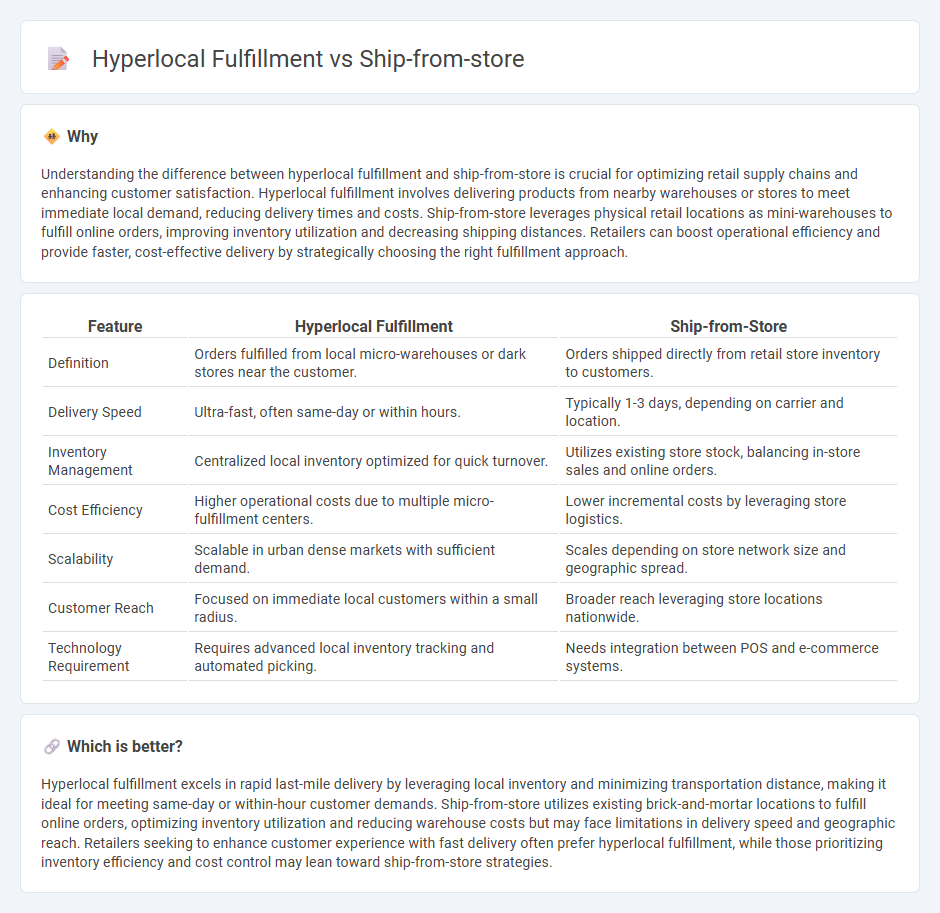
Hyperlocal fulfillment leverages local inventory to deliver products quickly within specific geographic areas, enhancing customer satisfaction through reduced delivery times. Ship-from-store utilizes physical retail locations as mini-warehouses to fulfill online orders, optimizing existing resources and expanding fulfillment capacity. Explore the benefits and strategic applications of both models to optimize your retail supply chain.
Why it is important
Understanding the difference between hyperlocal fulfillment and ship-from-store is crucial for optimizing retail supply chains and enhancing customer satisfaction. Hyperlocal fulfillment involves delivering products from nearby warehouses or stores to meet immediate local demand, reducing delivery times and costs. Ship-from-store leverages physical retail locations as mini-warehouses to fulfill online orders, improving inventory utilization and decreasing shipping distances. Retailers can boost operational efficiency and provide faster, cost-effective delivery by strategically choosing the right fulfillment approach.
Comparison Table
| Feature | Hyperlocal Fulfillment | Ship-from-Store |
|---|---|---|
| Definition | Orders fulfilled from local micro-warehouses or dark stores near the customer. | Orders shipped directly from retail store inventory to customers. |
| Delivery Speed | Ultra-fast, often same-day or within hours. | Typically 1-3 days, depending on carrier and location. |
| Inventory Management | Centralized local inventory optimized for quick turnover. | Utilizes existing store stock, balancing in-store sales and online orders. |
| Cost Efficiency | Higher operational costs due to multiple micro-fulfillment centers. | Lower incremental costs by leveraging store logistics. |
| Scalability | Scalable in urban dense markets with sufficient demand. | Scales depending on store network size and geographic spread. |
| Customer Reach | Focused on immediate local customers within a small radius. | Broader reach leveraging store locations nationwide. |
| Technology Requirement | Requires advanced local inventory tracking and automated picking. | Needs integration between POS and e-commerce systems. |
Which is better?
Hyperlocal fulfillment excels in rapid last-mile delivery by leveraging local inventory and minimizing transportation distance, making it ideal for meeting same-day or within-hour customer demands. Ship-from-store utilizes existing brick-and-mortar locations to fulfill online orders, optimizing inventory utilization and reducing warehouse costs but may face limitations in delivery speed and geographic reach. Retailers seeking to enhance customer experience with fast delivery often prefer hyperlocal fulfillment, while those prioritizing inventory efficiency and cost control may lean toward ship-from-store strategies.
Connection
Hyperlocal fulfillment and ship-from-store models are interconnected strategies that optimize inventory use by fulfilling online orders directly from nearby retail locations, reducing delivery times and shipping costs. By leveraging local store inventory, retailers enhance customer satisfaction through faster, more accurate order fulfillment. This approach increases store-level inventory visibility and improves overall supply chain agility in the retail sector.
Key Terms
Inventory Management
Ship-from-store leverages existing retail inventory to fulfill online orders, reducing delivery times and optimizing stock turnover across multiple locations. Hyperlocal fulfillment relies on strategically located micro-warehouses or local stores to manage inventory, enhancing last-mile delivery efficiency and minimizing transportation costs. Explore how these inventory management strategies can transform your fulfillment operations for better customer satisfaction.
Delivery Speed
Ship-from-store leverages local inventory by fulfilling online orders directly from nearby physical stores, significantly reducing delivery time compared to traditional centralized warehouses. Hyperlocal fulfillment utilizes a network of micro-fulfillment centers within neighborhoods to ensure ultra-fast deliveries, often within hours, by optimizing last-mile logistics. Explore the key differences in delivery speed and efficiency to decide the best strategy for your business needs.
Order Routing
Ship-from-store fulfillment routes orders directly from the nearest physical retail location to the customer, optimizing delivery speed and reducing shipping costs by leveraging existing store inventory. Hyperlocal fulfillment expands this concept by integrating a network of local suppliers, dark stores, and micro-fulfillment centers, allowing more dynamic order routing based on real-time inventory and proximity to the consumer. Explore more about how advanced order routing algorithms enhance efficiency and customer satisfaction in these fulfillment models.
Source and External Links
What Is Ship From Store? Create Your Strategy (2025) - Shopify - Ship-from-store is a retail fulfillment strategy where an online order is fulfilled from a physical retail location closest to the customer rather than from a central warehouse, enabling faster delivery times and smoother omnichannel retail operations.
Ship From Store: Definition, Operation & Key Benefits - OneStock - Ship From Store uses an Order Management System (OMS) to unify stock across all stores and allocate online orders to the best store for fulfillment, turning retail points of sale into mini-warehouses to reduce delivery times and avoid stock-outs.
Ship From Store: The Good, Bad, & The Ugly - ShipBob - By shipping orders from local stores, retailers expand their geographic reach, reduce shipping costs, and speed up delivery, but challenges include managing order volume in stores and using appropriate packaging for shipped items.
 dowidth.com
dowidth.com